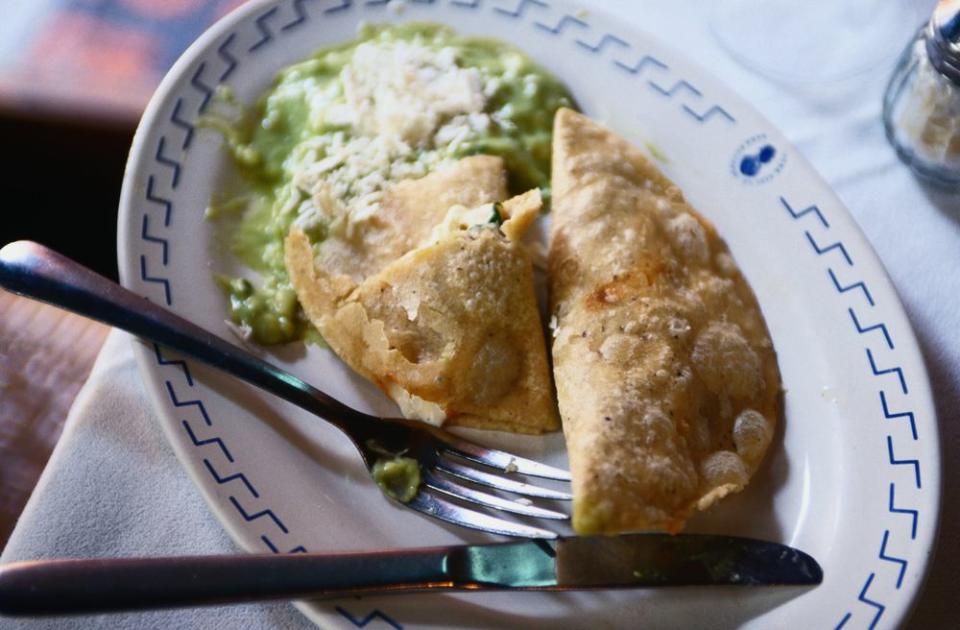This Breathtaking Mexico City Restaurant Is a History Lover's Dream
Café de Tacuba is a portal. Step off the busy street of Calle Tacuba in Mexico City’s historic district, where the storefronts are tightly packed and car exhaust colors business awnings. Walk through the restaurant's window-stained double doors and prepare to enter Mexico's colonial past. Inside Café de Tacuba, little has changed since it opened its doors in 1912.
Housed in a former convent, the restaurant is one of the oldest restaurants in North America’s largest city. In fact, the street on which the restaurant is located—Calle de Tacuba—is said to be the city's first road. Walking into Café de Tacuba's dining room means following in the footsteps of Diego Rivera, Mexican presidents, and local rockstars.
A post shared by Pablo E. Nagano Vargas (@nagano1987) on Jul 21, 2018 at 10:06am PDT
But do not expect smiling photos of famous guests on the walls. The restaurant’s decor is an ode to Mexican artistry. Brass chandeliers dangle from the ceiling, colonial artwork hangs on every wall, and talavera—pottery indigenous to Puebla and Tlaxcala—accents stairs, hallways, and the dining room. (Much like Champagne, pottery can only carry the name of talavera if it is comes from these states.) At all hours, Mariachis walk through the dining room serenading guests.
"We wanted decor that was durable, beautiful, and showed off Mexico's talent," says Juan Pablo Ballesteros, the great-grandson of Dionisio Mollinedo Hernández, who first opened the 20th-century concept, intersecting with the country’s indigenous roots and colonial rule.

This ethos is evident on the menu, too. The restaurant is rich with corn-based food—an indigenous ingredient that survived Spain’s 300 years in power. Maize, a corn-based flour, is used in tamales, atole, and enchiladas. Before ordering, make sure to heed the menu's disclaimer: expect to wait 20 to 30 minutes for your food. Why? Because the kitchen follows original recipes dating back decades, so things take time.
“The recipes used here haven't changed in 50 to 60 years,” says Ballesteros. “It’s like entering someone’s memories, or even your own. Stepping in here means entering the golden years of Mexico City.”
Ballesteros credits the restaurant’s longevity to its commitment to consistency. According to him, it's why several generations of families keep coming back: they know what to expect. Some want to relive memories. While many restaurateurs busy themselves with staying relevant, Café de Tacuba does not. New menu items are almost never added. When they are, they're offered as specials, not as permanent options.
A post shared by Jose Reyes Lulet (@joserlulet) on Jul 8, 2018 at 4:55pm PDT
“Many of Mexico's recipes were made in churches and monasteries,” says Ballesteros. “By Mayora nuns.” Centuries ago these nuns were charged with feeding compounds of people. They learned to prepare mass meals, focusing on flavor rather than technique.
“They’re not trained chefs,” says Ballesteros. “They cook out of devotion for the people and to serve God. They make what’s tasty.” Mayora—similar to chef—is a moniker used to describe someone who falls in this category. And it is these women who run Café de Tacuba’s kitchen.
There is no Mayora school; the knowledge and training is passed down from one generation to the next. Today, the restaurant employs Patricia Trejo Lozano—a third-generation Mayora—to oversee its operation. If and when the time comes to replace her, the family will look within their own kitchen to make a selection.

From its inception, the restaurant has been committed to only using products native to the country. They source from neighboring towns, or other states such as Puebla, Hidalgo, and Oaxaca. The intention is to spotlight Mexican cuisine, allowing the restaurant to flourish as interest in (and appreciation of) its food continues to grow.
Rather than adopting fashionable techniques or culinary trends, Ballesteros and his family hope to show customers the world through their eyes. This has put Café de Tacuba decades ahead of the gastronomical boom happening around Mexican food—further driving its success. Interest in mezcal, insects and older pre-Hispanic recipes like champurrado might seem relatively new, but for the restaurant’s kitchen, these are staples the staff grew up on. Rather than minimize their indigenous roots, the ownership spotlights them.
“We want to believe that at this restaurant, we are a tiny part of it all,” says Ballesteros. “We are a tiny part of Mexico's identity. But, Mexico is the sum of its parts. And we’ve been right there alongside her major milestones, for more than a century. This place connects you to our culture and our traditions. We don’t plan to change that.”

